Introduction
The concept of stress has evolved with time, research and the approach of the authors; likewise, interest has grown in this topic that today affects a large number of people worldwide. In 1954 the term “stress” was popularized by Hans Selye, who described it as a reaction to a threat in the environment that provokes a psychophysiological response in the person (as cited in Cárdenas et al., 2014). Years later, researchers found a biological explanation for stress, since the body when reacting to a stimulus activates the HPA axis and the sympathetic nervous system; these cause the adrenal medulla to secrete hormones (adrenaline and noradrenaline), thus affecting physiological aspects such as excessive sweating, blood pressure and heart rate. This triggers a hormonal release of glucocorticoids, and insufficient or excessive production of glucocorticoids can affect memory, inhibition and other cognitive aspects of the individual (Giler et al., 2022; Cordova-Buiza et al., 2022; La Torre-Torres et al., 2022; Machuca-Vílchez et al., 2023). Therefore, it is of utmost importance to investigate stress in the different environments in which the person is found, because these problems can affect his or her performance in the environment.
Work Stress
The world of work has been constantly changing due to various factors such as technology, competitiveness, demands and requirements of workplaces, among others; all this often causing negative reactions such as work stress. According to Alvites (2019), work stress is an automatic response to situations in which the worker feels pressured or has an inadequate work environment, thus causing him/her not to have the ability to fulfill his/her responsibilities correctly. With this definition, it can be stated that work stress is a set of reactions that a person presents when faced with different harmful circumstances in the workplace.
Additionally, work stress brings with it several consequences in the workers such as: decrease in productivity, concentration problems and anxiety disorders due to not being able to cope with the work demands, being something harmful for the company since all this often ends up in a high personnel turnover. This is supported by Urquidi and Rodríguez (as cited in Cárdenas et al., 2014) who indicate that work stress can cause the collaborator to be absent from his functions in the company, have a lower productivity than that of his other colleagues and may even abandon his job.
According to Villamar et al. (2019), negative psychosocial factors such as work stress can have consequences for the company such as low performance or absenteeism in the collaborator. Therefore, it can be affirmed that work stress can become detrimental to organizations, since it can cause lack of commitment and job dissatisfaction in the worker, thus generating low performance indexes.
Work Performance
Regarding performance and from a subjective point of view, teaching performance is related to how the teacher perceives his/her work quality and how satisfied he/she is with his/her work; approached from an objective point of view, it is associated with the quantification of the indicators evaluated by the university (Fernández, cited by García et al., 2017). That indicates that each university can evaluate performance in a different way and this will depend on the workload of the collaborator.
On the other hand, according to Cárdenas et al. (2014), the two most stressful jobs are teaching and nursing. With this, it can be indicated that teaching is considered one of the most stressful professions, since it has a large workload and often lacks time to fulfill all of it; many teachers work outside their working hours, either for the development of educational material, to answer any questions from the students, among others.
The influence of Work Stress on Performance
Job stress caused by various factors has a negative influence on the performance level of teachers. As indicated by Acosta et al. (2019), stress in teachers is usually a product of their own teaching functions along with other causes, which negatively affects their performance and productivity, thus generating a low quality of teaching. Similarly, according to Villarruel et al. (2018), work stress, caused by the high standards currently demanded, can trigger negative alterations and, thus, be a risk for the correct work performance. With this, it is stated that stress generates consequences such as lack of concentration thus affecting work performance.
In Ecuador, research was conducted in various Higher Education Institutions in the city of Guayaquil, through surveys to a total of 159 teachers; where it could be observed that, in the vast majority of respondents, work stress and burnout has a harmful impact on teachers’ performance and health (Rivera et al., 2018). On the other hand, in the same country of Ecuador, according to Soriano (2021), a study was conducted to 78 administrative collaborators of the Peninsula de Santa Elena State University, where stress and work performance were evaluated; it was obtained that workers do not present work stress and exceeded 91% in their performance evaluation. Therefore, it can be indicated that with the absence of work stress, higher performance indexes are obtained.
In addition, a study carried out at the University of Carabobo in Venezuela shows that 49% of teachers have a medium-high level of depersonalization (a stress factor) and 16% have a maximum degree of stress (burnout) generating frustration with their teaching work and distancing with their students, this added to the lack of teaching resources and infrastructure compromises the exercise and performance of their teaching work (Bustamante et al., 2016). In addition, university teaching exposes professors in Latin America to more stress due to the demand of their functions and the social characteristics that surround them (Monroy and Juárez 2019). Therefore, with these studies, it can be verified that work stress is present above all in the Latin American educational environment.
In Peru, the university stage is one of the most significant because it lays the foundations for the student’s future as a professional and citizen with ethics and values; therefore, it is sought that he/she has the desire to investigate and put into practice the knowledge acquired theoretically (…. ); the above could not be carried out without the work of university teachers, who are responsible for teaching and developing new knowledge, as mentioned by the Ministry of Education (as cited in Mendoza, 2022) when it says that the teacher’s responsibility goes beyond educating students but also has the responsibility to research, innovate and train in relevant issues of the global context. This causes teachers and university collaborators a workload that could be translated into work stress, thus affecting their ability to perform the tasks assigned to them.
Similarly, the work environment can undermine the mental health of university teachers; according to Jiménez and Ríos (2018), some factors that can influence are low socioeconomic status, a decrease in salary, lack of teaching tools, excessive workload, among others that affect the performance and commitment of teachers to their work. Likewise, according to Tacca and Tacca (2019) in a study conducted in Peru, in the city of Lima, 117 teachers from public and private universities were surveyed; and the result was that hired teachers suffer from stress at a much higher level, causing problems to fall asleep, exhaustion and deconcentration, thus creating an impact on their performance, health and professional satisfaction.
Due to the above, the problem to be addressed is: What is known about the influence of work stress on the performance of collaborators in Higher Education Institutions in the scientific literature between 2012 and 2022? Consequently, the objective of the present study is to analyze what has been written in the scientific literature on the influence of job stress on the performance of collaborators in Higher Education Institutions in Latin America within the period 2012-2022.
Methodology
The present research work uses the empirical literature search methodology, which is responsible for collecting, analyzing and selecting various scientific articles based on reliable data on the variables of study, these being job stress and job performance. According to Pimienta et al. (2018), research is a systematic activity, since it is done in an orderly manner; verifiable, because it seeks to understand situations through the search for evidence; and empirical, since it is based on experiments and experiences.
On the other hand, there is a large number of databases where several scientific articles can be found. This is mentioned by Pimienta et al. (2018) by indicating that databases are extremely important tools that help the researcher to find research articles, theses, reports, e-books and other documents from all over the world. Likewise, the databases chosen are Dialnet, Redalyc, Scielo and Ebsco, obtaining a total of 25 articles. Additionally, keywords were used to find articles that help with the research, such as: ”job stress”, ”job performance”, ”institute” and ”university”; and by synonyms such as ”job burnout”, ”job fatigue”, ”burnout”, ”job performance”, ”job productivity” and ”job engagement”. Also, the method of connectors such as ”and” and ”in” was used, allowing us to find much more complete articles.
Regarding the data selection procedure, first we decided on the search tools to be used, opting for databases, since they are considered more reliable and specific than search engines. Then, we proceeded to perform the searches by applying year and country filters: In the Dialnet database, we decided to use the phrase “Stress and work performance in universities” and found a total of 34 articles. In Ebsco, the words “work performance”, “work stress”, and “universities” are used through the advanced search tool, obtaining a total of 335 documents. In Redalyc, the phrase ”job stress and job performance in higher education institutions” was used for the search, obtaining 9,713 articles. In Scielo, the phrase ”job stress in job performance” was searched, obtaining 3,780 articles.
As shown in Figure 1, when starting the search for information in the databases (Redalyc, Scielo, Ebsco and Dialnet) and applying the corresponding filters, 13,862 studies published between 2012 – 2022 were found of which the majority are from Redalyc and Scielo, since they offer a greater number of results than the others and provide the option of filtering by year of publication, language and country. Taking into account various criteria such as duplicate records eliminated, ineligible by automated tools and eliminated for other reasons, 12,934 articles were excluded, leaving 928 screened records. Subsequently, by analyzing the title and abstract of the studies, 433 records were excluded, yielding 495 reports searched for retrieval. Then, some articles could not be opened, so 186 reports were discarded, leaving 309 reports screened for eligibility. After reviewing the studies, 288 reports were excluded for four reasons: no relation with the study population, not answering the research question, not studying the reality of Latin America, and not complying with the IMRD; obtaining 21 new studies included. On the other hand, 16 records of websites and organizations were found, of which 2 were not retrieved, leaving 14 reports evaluated for eligibility. Then, 10 reports were excluded for the same reasons mentioned above, obtaining 4 articles. Finally, a total of 25 studies were included, of which 11 are from Scielo, 6 from Redalyc, 2 from Ebsco and 6 from Dialnet; these articles being the most suitable for the analysis of the influence of work stress on the performance of collaborators in higher education institutions within the period 2012-2022, due to their specific and relevant information.
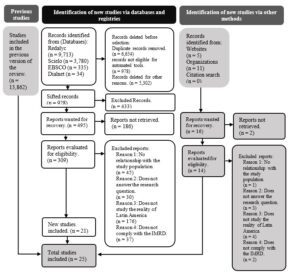
Fig 1. Prisma 2020 flowchart
Results and Discussion
This chapter presents all the findings of the 25 articles that were selected after an exhaustive search of the databases. This information is classified according to different criteria and methodological filters and is organized in tables and figures. All of this is of vital importance for the present research, since it provides relevant information on the topic of interest.
Table 1 shows the 25 articles considered for the research, which passed through various selection criteria filters such as: range of year of publication (2012 to 2022), IMRD structure, reality of Latin American countries, relationship between the two variables of interest and the study population.
Table 1: Selected Articles

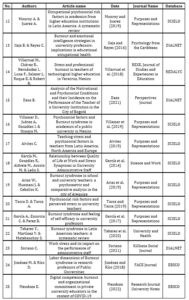
When determining the region from which information was to be found, some Latin American countries were identified as being of vital importance for the research.
As can be seen in Figure 2, most of the articles selected were from Mexico with 32%, being the country with the largest amount of research on the variables of interest; while Chile has very little information, with 4% of the total.
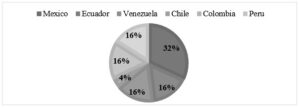
Fig 2. Countries according to the selected articles
As shown in Figure 3, 2019 was the year in which more articles of interest were found, obtaining 7 out of 25 in total, thus achieving more recent studies; on the contrary, in the years 2015 and 2017, only 1 article was found respectively, being the years with the least contribution.
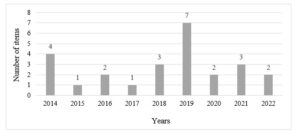 Fig 3. Year of publication of the selected articles
Fig 3. Year of publication of the selected articles
Figure 4 shows the population studied in the articles, showing that most of them study teachers and their relationship with stress and performance (21 articles representing 84% of the total), since teachers are those who have a high workload and a great educational commitment to students. While a total of 2 articles investigated the administrative staff of the university, with 8% of the total number of articles; and two others also investigated support personnel and workers, with 4% representation each.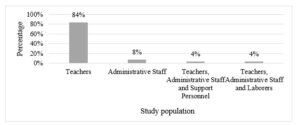
Fig 4. Study population in the articles
Table 2 reveals that 19 of the 25 research articles are quantitative in approach, this is because the most commonly used tools for the investigation of the variables of “job stress” and “job performance” are already established questionnaires that yield statistical and quantifiable data. While the articles with a qualitative approach are 3, these were based on the collection of information from other research; that is, they are systematic reviews. On the other hand, 3 articles combine the two approaches to obtain more enriching research; one of the mixed approach articles uses the interview as a tool and the other 2 research articles with this approach use the questionnaire as a tool.
Table 2: Methodological analysis of the selected articles

Figure 5 shows five types of quantitative level questionnaires that were most used in the research, with the Maslach Burnout Inventory Questionnaire (MBI) having the most presence, with 9 items in total; this is a well-known questionnaire that assesses burnout and its three dimensions, which has a relationship with the study variable (job stress). Meanwhile, Cohen’s Perceived Stress Scale Questionnaire, the Psychosocial Factors of Academic Work Questionnaire (FPSIS) and the Teacher Performance Evaluation Questionnaire tied as the least used, with 2 items each.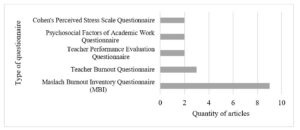
Fig 5. Type of questionnaire at a quantitative level
Table 3 shows the similarity themes for the variables “job stress” and “job performance” such as: emotional exhaustion, burnout, depersonalization, psychosocial factors and risks, dissatisfaction, organizational commitment, teaching performance, motivation, productivity, satisfaction and work overload.
Table 3: Themes of similarity with the study variables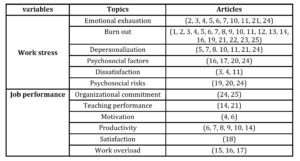
According to Monroy and Juarez (2019), the relationship of stress with psychosocial factors occurs when factors such as workload, deficiency in educational materials and demands on the performance of the collaborator can cause mental pathologies such as stress. Likewise, work stress at its highest point can become Burnout, affecting the physical and emotional health of the person and influencing their performance in their work (Bustamante et al., 2016; Cárdenas et al., 2014).
As mentioned above, work stress can reach a chronic level, which generates the appearance of various symptoms such as emotional exhaustion; this arises due to the loss of emotional resources of the worker, presenting fatigue both physically, mentally and emotionally, and causes in the worker a feeling of not being able to offer more of himself for the fulfillment of the functions. All this causes concentration problems and low productivity (Balseiro, 2010, as cited in Valadez et al., 2014).
Likewise, according to Rivera et al. (2018), another symptom of having high levels of stress (burnout) is depersonalization, which is a negative change in which the collaborator uses a shield or creates a defense mechanism that allows him to distance himself from the people around him (whether colleagues, students, supervisors, etc.); in this way, the collaborator is cynical, annoyed, distant and sometimes may blame others for his poor performance.
In addition, in stressful situations, collaborators generally cannot concentrate properly and have a lower performance than others; with this, they develop negative feelings such as dissatisfaction in their workplace, since they cannot perform as they wish and feel that their efforts are not enough to meet the proposed objectives, thus generating that they do not enjoy their work experience (Rivera et al., 2018).
Jiménez and Ríos (2018) and Arias et al. (2019) mention that work stress is very common in teaching work, being a psychosocial risk product of poor work organization and that it can be eliminated if collaborators work together with coordinated activities and shared responsibilities.
On the other hand, when a worker has a high motivation towards the performance of his duties, he has no problem to fulfill his tasks properly, since he feels very good about what he is doing and shows his loyalty to the organization, so this factor is essential if good results are desired, not only in productivity but also in the organizational climate (Cárdenas et al., 2014).
In addition, organizational commitment is an essential element for good work performance, because with it, workers, in addition to seeking their own well-being, also pursue the success of the company. A committed employee feels happy, valued and proud to be where he/she is, which results in a better work environment and an increase in the company’s profits (Mendoza 2022).
Similarly, according to Cárdenas et al. (2014), research shows that productivity is linked to performance, specifically to teaching performance; this is due to the fact that this work, being demanding and with a heavy workload, must be balanced with a high level of productivity, thus demonstrating the efficiency of the worker and the quality of the educational institution.
Finally, performance can also trigger work overload, especially in the university context where many people depend on the good service provided both in and out of the classroom, which generates pressure on professionals and increases the workload with long working hours, varied schedules and the fulfillment of administrative functions in addition to their academic functions (Daza 2021).
Figure 6 shows the influence that work stress has on the performance of collaborators in Higher Education Institutions, according to the information reviewed in the 25 articles previously described.
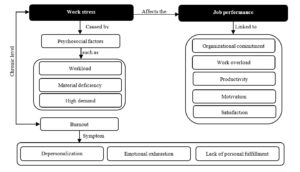
Fig 6. Diagram of the influence of work stress on performance
Conclusions
The present work is a systematic review that uses empirical literature search as a research tool, which synthesizes information from various research articles helping to contrast data, theories, results and findings from Latin American countries; allowing to understand and define the variables of “job stress” and “job performance”, as well as the influence of one on the other. About the empirical methodology, Rodriguez and Perez (2017) mention that it is used to collect information that allows testing the hypothesis raised in the study; in addition to providing data that help to answer the research problem.
Regarding the methodological approach, 76% of the articles are quantitative, 12% qualitative, and the other 12% are mixed. This was of great help for the study of the results, since the most used tool was the questionnaire, which allows measuring the levels of stress and performance with greater accuracy, thus obtaining data that demonstrate the reality of the collaborators in Latin American HEIs and that serve as the basis for the present work.
On the other hand, one of the limitations encountered during the preparation of the study was to find relevant information on the study variables and their relationship, since some articles did not address both variables in depth. Additionally, the number of articles with the variables in the context of higher education was limited, due to the fact that the topic has been gaining importance in Latin America in recent years. Likewise, certain articles did not present the IMRD structure necessary for them to be considered in the research. In addition, when searching for variables in the databases and applying the filters (years, countries, language and type of document), the search results showed erroneous articles that were not related to the topic under investigation, thus hindering and delaying the research and the findings.
It should be noted that most of the studies found on the variables of interest in the field of higher education focus more on teachers, followed by administrative staff and finally support staff, of which there is very little information. Likewise, stress added to psychosocial factors can reach higher levels and become Burnout, generating consequences such as emotional exhaustion and depersonalization, causing the worker to feel demotivated and lose interest in their functions, thus impairing their efficiency and performance.
With respect to teachers with burnout, they show more emotional exhaustion than depersonalization or lack of personal fulfillment; this is due to the bond and/or sense of commitment they have with the educational institution. In addition, in the case of teaching, stress occurs due to excessive workload, undefined work schedules and extra duties; thus, negatively affecting their job performance.
On the other hand, some studies claim that no evidence was found to indicate that there is a relationship between work stress and teacher performance, or that it is weak and not significant. In addition, a small number of articles mention that the greater the commitment to the institution, the greater the satisfaction and performance of the collaborator, which will prevent the occurrence of chronic and high stress in the person.
In conclusion, most of the research indicates that there is a negative influence of work stress on the performance of collaborators in Higher Education Institutions, causing the worker to be unable to comply with their scheduled activities, in addition to presenting: fatigue, emotional exhaustion, depersonalization and low productivity.
Therefore, it would be advisable that universities and institutes generate and create a healthy environment with favorable laws and norms for their collaborators, thus decreasing the psychosocial factors that can trigger work stress and, consequently, affect their performance. In addition, it is suggested that future research should focus not only on teachers, but also on other populations of Higher Education Institutions such as administrative and support staff, since they are also in a demanding work environment and have contact with students and their training.
References
- Acosta, A., Jiménez, L., Pulido, E. and Miladys, R. (2019), ‘Occupational stress and performance evaluation in university teachers in the department of Cesar’, Encuentros, 17 (1), 24-33.
- Alvites, C. (2019), ‘Teacher stress and psychosocial factors in teachers from Latin America, North America and Europe’, Purposes and Representations, 7 (3), 142-159.
- Arias, W., Huamani, J. and Ceballos, K. (2019), ‘Burnout Syndrome in school and university teachers: a psychometric and comparative analysis in the city of Arequipa’, Propósitos y Representaciones, 7 (3), 72-110.
- Bustamante, E., Bustamante, F., González, G. and Bustamante, L. (2016), ‘Burnout in the teaching profession: a study at the School of Bioanalysis of the University of Carabobo Sede Aragua, Venezuela’, Medicina y Seguridad del Trabajo, 62 (243), 111-121.
- Cárdenas, M., Méndez, L. and González, M. (2014), ‘Performance, stress, burnout and personal variables of university teachers’, Educere: The Venezuelan Journal of Education, 18 (60), 289-302.
- Cárdenas, M., Méndez, L. and González, M. (2014), ‘Evaluation of teaching performance, stress and burnout in university professors’, Research News in Education, 14 (1), 1-22.
- Cordova-Buiza, F., Aguirre-Parra, P., Garcia-Jimenez, M. G. and Martinez-Torres, D. C. (2022), ‘Virtual leadership as a development opportunity in business context’, Problems and Perspectives in Management, 20 (2), 248-259.
- Daza, B. (2021), ‘Analysis of the Motivational and Psychosocial Conditions and their Incidence on the Performance of the Teacher of a University Institution in the City of Bogotá’, Perspectives Journal, 6 (2), 69-80.
- García, A., Escorcia, C. and Perez, B. (2017), ‘Burnout Syndrome and feelings of self-efficacy in university professors’, Purposes and Representations, 5 (2), 65-126.
- García, A., Escorcia, C. and Pérez, B. (2017), ‘Burnout Syndrome and feeling of self-efficacy in university professors’, Purposes and Representations, 5 (2), 65-126.
- Giler, R., Loor, G., Urdiales, S. and Villavicencio, M. (2022), ‘Burnout Syndrome in university teachers in the context of the COVID-19 pandemic’, Dominio de las Ciencias, 8 (1), 352-374.
- Ilaja, B. and Reyes, C. (2016), ‘Burnout and emotional intelligence strategies in university professors: implications for educational occupational health’, Psychology from the Caribbean, 33 (1), 31-46.
- Jiménez, M. and Ríos, D. (2018), ‘Labor dimensions of burnout syndrome in research professors of public universities’, Face: Faculty of Economic and Business Sciences, 18 (2), 97-108.
- Jorquera, R. and Herrera, F. (2020), ‘Mental health in civil servants of a Chilean university: challenges in the context of COVID-19’, RIDU: Digital Journal of Research in University Teaching, 14 (2), 1-13.
- Machuca-Vílchez, J. A., Ramos-Cavero, M. J. and Cordova-Buiza, F. (2023), ‘Knowledge management in financial education in peruvian government programs focused on women: Progress and challenges’. Knowledge and Performance Management, 7(1), 1-14.
- Mendoza, E. (2022), ‘Digital competence, burnout and organizational commitment in private university educators in the context of COVID-19’, Apuntes Universitarios Research Journal, 12 (3), 446-464.
- Monroy, A. and Juárez, A. (2019), ‘Occupational psychosocial risk factors in academics from higher education institutions in Latin America: A systematic review’, Purposes and Representations, 7 (3), 248-272.
- La Torre-Torres, M. T., Pando-Medina, Z. M., Aragon-Ortega, P. M. and Cordova-Buiza, F. (2022), ‘Administrative management and work performance in hardware and construction SMEs: The case of Justiniano Soto Villanueva S.R.L., Peru’. IBIMA Business Review, 2022.
- Rivera, Á., Segarra, P. and Giler, G., ‘Burnout Syndrome in teachers of higher education institutions’, Venezuelan Archives of Pharmacology and Therapeutics, 38 (2), 17-25.
- Rodríguez, A. and Pérez, A. (2017), ‘Scientific methods of inquiry and construction of knowledge’, Revista EAN, 82 (1), 179-200.
- Rojas, J., Flores, G. and Cuaya, I. (2021), ‘Main methodological aspects in the study of work stress in university personnel: A systematic review’, RIDU: Digital Journal of Research in University Teaching, 15 (1), 1-16.
- Sapién, A., Piñón, L., Gutiérrez, M. and Rubio, H. (2015), ‘ Burnout Syndrome in professors of a higher institution in Mexico’, Revista Publicaciones, 45 (1), 53-64.
- Seijas, D. (2019), ‘Psychosocial risks, occupational stress and burnout syndrome in university workers from a bioanalysis school’, Revista de Salud Pública, 21 (1), 102-108.
- Soriano, C. (2021), ‘Work stress and its impact on the performance of administrative staff’, Killkana Social Journal e, 5 (1), 1-8.
- Tabares, Y., Martínez, V. and Matabanchoy, S. (2020), ‘Burnout Syndrome in Latin American teachers: A systematic review’, Universidad y Salud, 22 (3), 265-279.
- Tacca, D. and Tacca, A. (2019), ‘Psychosocial risk factors and perceived stress in university teachers’, Purposes and Representations, 7 (3), 323-353.
- Valadez, A., Bravo, M. and Vaquero, J. (2014), Percepción de las fuentes de estrés laboral y sus efectos en el docente universitario’, Sociedad Mexicana de Medicina Conductual, 4 (1), 21-30.
- Villamar, D., Juárez, A., González, I. and Osnaya, M. (2019), ‘Psychosocial factors and Burnout syndrome in academics from a public university in Mexico’, Purposes and Representations, 7 (3), 111-140.
- Villarruel, M., Chávez, R., Hernández, I., Luna, F., Salazar, J., Roque, E. and Robert, R. (2018), ‘Stress and professional burnout in teachers of higher technological education in Veracruz, Mexico’, REXE: Journal of Studies and Experiences in Education, 17 (34), 113-128.












